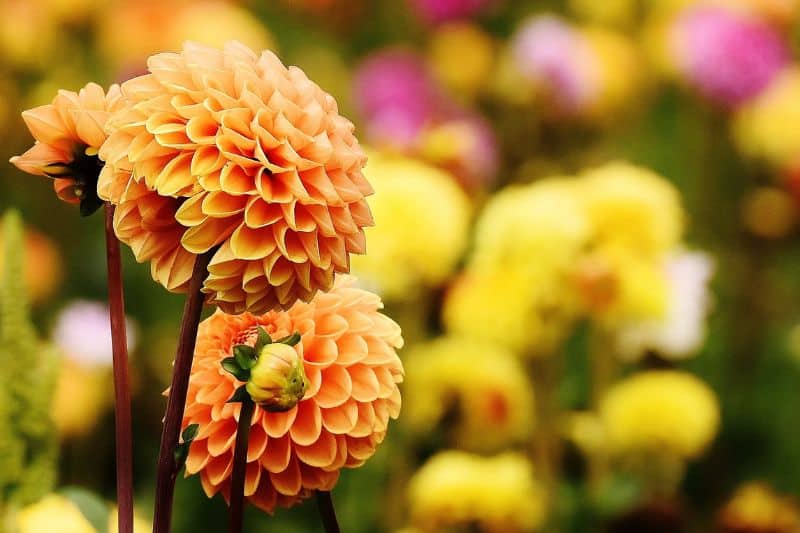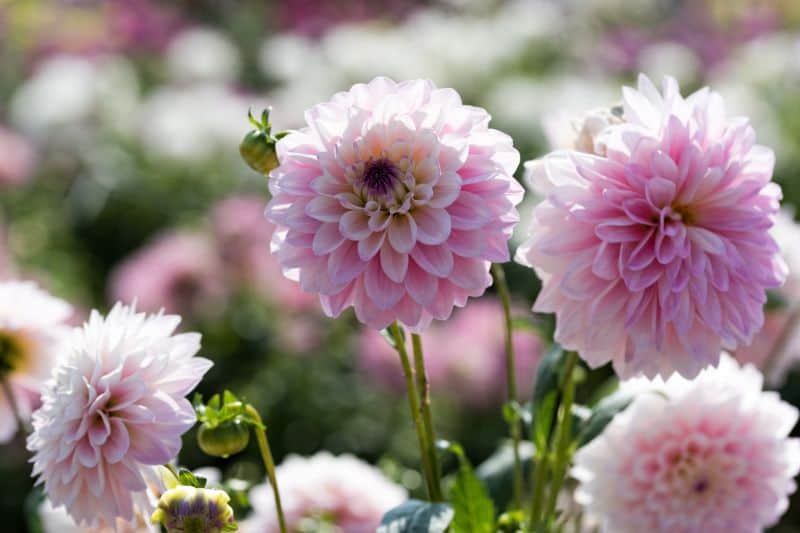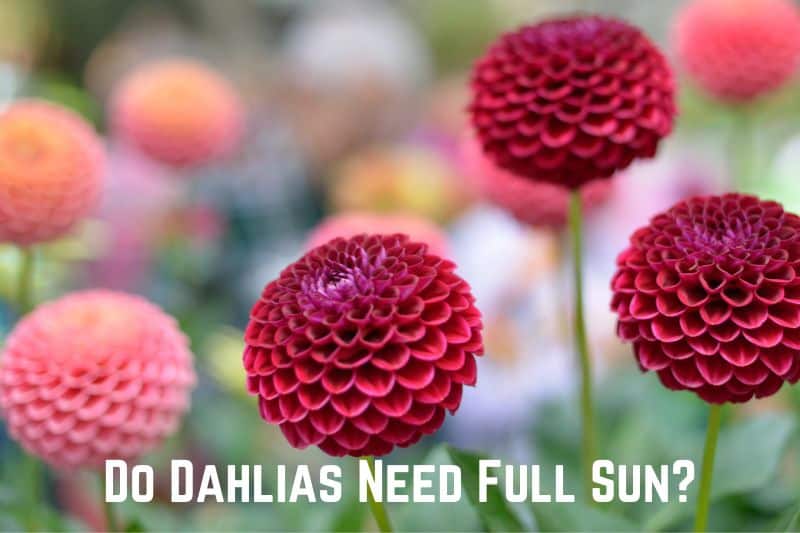Dahlias are a versatile flowering plant that’s part of the daisy family. They have gorgeous blooms that come in various colors and sizes, so you can add them to your garden regardless of its style. They’re easy to grow, even for beginner gardeners, but one of the tricky elements of their care is ensuring they get enough light. Do dahlias need full sun to grow?
Dahlias do require full sun, as this encourages the growth of their flowers. However, if you live in a region that experiences very hot summers, a bit of shade is a good idea to prevent them from drying out.
Read: Does Iris Need Full Sun? (Prefer Full Sun)
Do Dahlias Need Full Sun or Shade?
Dahlias prefer full sun, meaning they need at least six hours of direct sunlight daily to thrive and produce abundant flowers. But they should be given a bit of shade if the sun is too harsh, such as in the middle of summer in hot regions. Without enough sun, dahlias won’t bloom as much.
However, dahlias may benefit from some afternoon shade in hot climates to protect them from the intense heat. If you are planting dahlias, it is best to choose a location that receives full sun for most of the day, but has some shade during the hottest part of the day.
Planting dahlias in full sun is best, but there are some exceptions
- Dahlias thrive in gentle morning sun instead of harsh afternoon sun.
- If your region experiences hot and bright afternoons in summer, plant your dahlias in an area of the garden where they will get shade in the afternoons.
- The more sun you give your dahlias, the more they will bloom and their flowers will grow larger.
Can Dahlias Grow in Indirect Sunlight?
Dahlias can grow in indirect sunlight. They won’t die if they don’t receive full sun, but they won’t reach their growth potential either. Their flowers will struggle to grow and there won’t be as many blooms on the plant as those on dahlias grown in direct sun.
To prevent dahlias from drying out by the sun, aim to give them direct sun but plant them in a sheltered area, such as in a south-facing border. This ensures that they will get enough light that they need to thrive.
Dahlias bloom from the middle of summer all the way through until first frost. They have a long flowering period so you want to ensure they have all the sun they need to continue making your garden look lovely.
How Many Hours of Sun Do Dahlias Need?
Dahlias are sun-loving plants that need at least six hours of sunlight every day. However, aim to give them up to eight hours, as this will help them to produce more flowers.
Dahlia plants will look and grow healthier when they get enough sun. They will have bright green leaves and produce buds that open into flowers.

What Happens if Dahlias Don’t Get Enough Sun?
- If you plant dahlias in an area of the garden where they don’t get enough sun, they will be taller plants. This is a result of them becoming leggy as they try to reach for more sun. Leggy plants have weaker, thinner stems.
- A lack of sun will cause dahlias to struggle to produce larger blooms and a higher yield of flowers every growing season.
- When dahlias don’t receive enough sun daily, they might not bloom at all. This is a common problem people face when growing these flowering plants. Even though their leaves might appear healthy, the plants don’t have enough energy from the sun to produce flowers.
Can Dahlias Get Too Much Sun?
Although dahlias require full-sun conditions and between six and eight hours of sun daily, they dry out and stop flowering when exposed to hot temperatures. Avoid temperatures that are higher than 80°F (27°C) as this will prevent them from growing.
There is a risk that dahlias get too much sun. When this happens, you’ll notice the following on your plant:
- A lack of flowering. If dahlias get too much sun and very hot temperatures in summer, this can cause them to become stressed. The result is that they won’t produce flowers.
- Wilting. When exposed to very hot temperatures, dahlias will start to become droopy as a way to conserve their energy. This typically happens during hot, dry summers when temperatures soar.
- Dahlias with large flowers are the most sensitive to heat, so protect them.
Dahlias are a type of plant that doesn’t fare well in very hot conditions, so you have to protect your plants. You can do this by giving them a bit of shade, such as from a nearby wall or trellis that casts shade over them in the afternoon. Another idea is to cover the plants with shade cloth when temperatures are very high in your region.
Can Dahlias Grow in Shade?
Dahlias can grow in the shade, but they can only tolerate partial shade. If the temperature is very high in summer, they will benefit from partial shade. However, they still require full-sun conditions in order to grow healthy, avoid legginess, and produce lots of flowers.
The term ‘partial shade’ means that the plants should get between three and six hours of sun per day. So, if summers are hot in your region, going into the triple digits, you should protect your dahlias with a bit of shade in the afternoon.
How to Grow and Care for Dahlias?
Dahlias are popular flowering plants because of their beautiful and large flowers but also because they’re easy to maintain. Your dahlias will thrive as long as you have the following elements in their care.
Soil Requirements
- Dahlias require moist, well-draining soil. Adding organic matter, such as rotted manure, to their soil will give them the nutrients they require.
- You can grow dahlias in pots, but ensure you use a multi-purpose compost to enrich the soil with nutrients.
- Keep the soil pH to 6.5, as it should be neutral or slightly acidic.
Fertilizer Requirements
- Feed dahlias a high-phosphorus fertilizer so that they will bloom.
- Avoid giving your dahlias a fertilizer product containing too much nitrogen. This encourages leaf growth but won’t help the plant to flower.
Water Requirements
- Dahlias grown in pots or containers need excellent drainage. Drill a few holes in the bottom of the container so that the water won’t accumulate in the soil, which can cause root rot.
- Water your dahlias deeply twice a week. Increase watering if the weather is very hot or dry in your region. The soil should be moist to the touch, but never soggy.

When to Plant Dahlias?
- You should plant dahlias early in the spring. Check that the last risk of frost has passed, so the soil is warm enough for them to take root. Soil temperature should be around 60°F (15°C).
- When planting dahlia tubers, plant them about six inches (15.24cm) into the soil.
- Put the tuber in the ground with its “eye” (the area on the tuber where the stem will grow) upwards. Leave the eye exposed, but cover the rest of the tuber with soil.
- Leave about three feet (91.44cm) between dahlia tubers so they have enough room to grow.
- You can plant dahlia seeds, although these are more difficult to grow than tubers.
- Some dahlia varieties can grow up to five feet (152cm) in height so provide support in the form of metal rings or bamboo stakes.
Pruning Requirements
- When the plant has reached a height of approximately 12 inches (30.48cm), pinch the tips of stems located above a pair of healthy leaves. This boosts the plant’s production of new stems.
- Deadhead flowers when they have died. This encourages the plant to put in more energy into flower production.
- Although you don’t have to prune your dahlias, you should – it will keep the plants large and encourage them to grow more flowers.
Protection from Pests
- Garden pests such as snails are attracted to dahlias. Keep them away by adding rough mulch around the base of the plant.
- Placing crushed eggshells around the base of the dahlia plants is also a natural way to keep snails and slugs away.
- Keep the site where you’ve planted dahlias free of weeds. They are invasive and compete with the flowers for nutrients, and can also be a convenient place for pests to hide.
Overwintering Dahlias
Dahlias can grow and produce flowers every year if you overwinter them. Overwintering is a process when you protect the plant against freezing temperatures. How you care for your dahlias varies depending on your region.
Read: Do Begonias Need Full Sun? (Prefer Partial Shade)
- You can leave your dahlias in the ground during winter if you don’t get any frost and if you live in a USDA hardiness zone eight or higher.
- Keep potted dahlias indoors. After the first frost, dahlias enter dormancy. This is when you can cut them back so that they’re level with the soil. Move them indoors in a dry, dark place.
- If you live in a region where winters are freezing, dig up the dahlia tubers after the first frost. Clean them and keep them indoors. A good tip is to tie them with twine and hang them upside-down in a dry, cool place for a few weeks before storing them in a paper bag. You can add peat moss that’s sprayed with a bit of water to maintain a cool environment for them during the winter. When spring arrives, they’ll be ready to plant in the garden!






